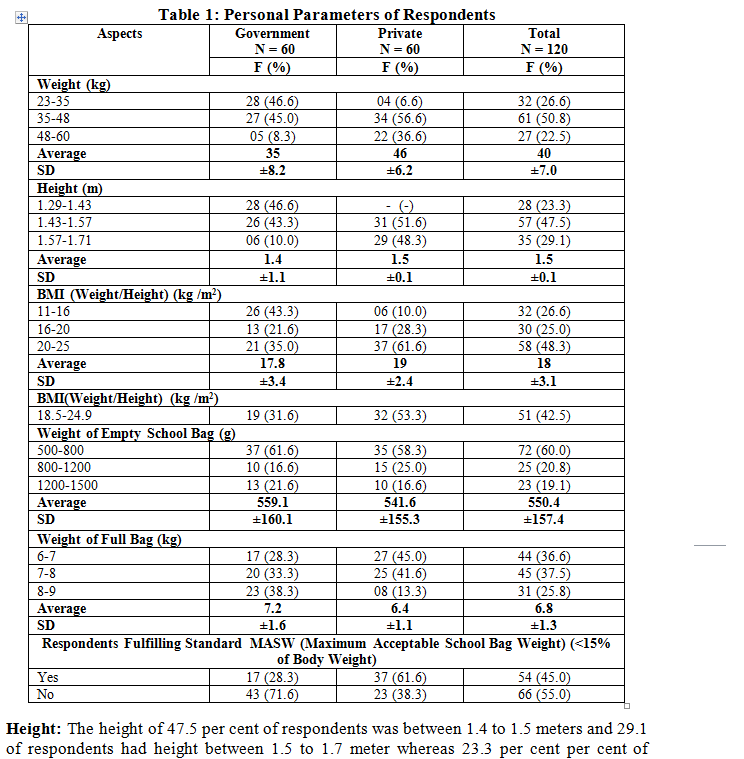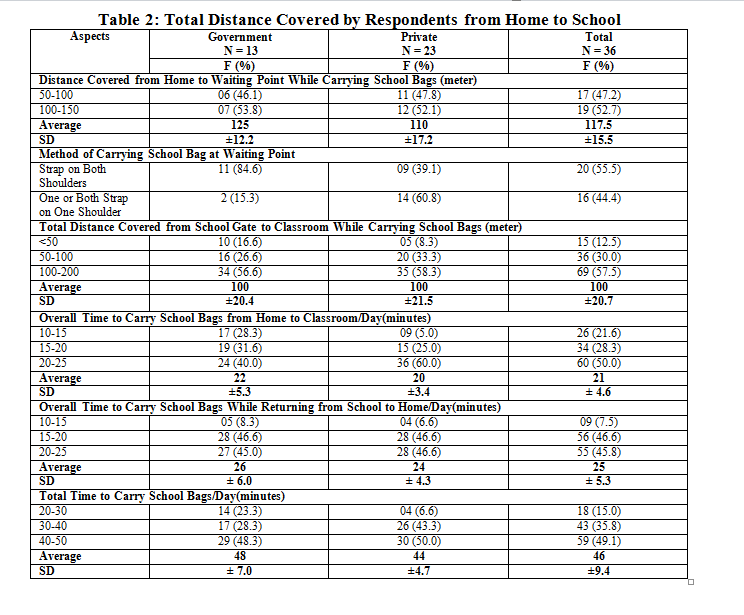Alleviation: An International Journal of Nutrition, Gender & Social Development, ISSN 2348-9340
Volume 2, Number 2 (2015) : 1-7
©Arya PG College, Panipat & Business Press India Publication, Delhi
www.aryapgcollege.com, www.apcjournals.com
Assessment of Factors Contributing to Awkward Posture in Children While Carrying their School Bags
1. Kanchan Pant, 2. Harpinder Kaur & 3. Munider Sidhu
1 Professor, 2 Associate Professor ,3 Research Scholar
Department of Family Resource Management, College of Home Science, PAU, Ludhiana (Punjab), India
E-mail: harp_07@pau.edu
Introduction
Back pain due to awkward posture in children is much more likely to have a serious underlying disorder compared with adult back pain and deserves careful attention Unfortunately the diagnosis of serious disease causing back pain in children is often made late or missed completely. Pascoe et al (1997) found that the prolonged carrying of heavy backpacks could lead to symptoms of body soreness, aches, pains and tiredness in children. The effect of load carriage on posture during stair walking was studied and found that when the load is 10 per cent or greater of the body weight, it induced greater trunk-forward inclination in subjects on ascending stairs (Hong et al 2003). In 2010, in Greece a study was conducted on 703 boys and girls aged between 6 to 14 years and body weight, standing height and schoolbag weight were measured and perceptions regarding schoolbag load were obtained using reliable questionnaire (Kellis and Emmanouilidou 2010). Study showed that younger students were almost 5 times more likely to carry heavier bags, the girls were twice more likely to experience fatigue when carrying schoolbags compared with boys. They concluded that, younger children are in greater need for education about schoolbag weight compared with older ones. Therefore, the present study was conducted to assess various factors contributing to awkward posture of children while carrying their school bags.
Materials and Methods
The study was conducted in Ludhiana city. Two zones were randomly selected. Out of these zones, further five governments and five private schools were randomly selected. A sample of 120 students and their mothers were taken from these selected schools from class vith to viiith. The age group was between 11 to 14 years. The questionnaire was formulated to collect data regarding contributing factors for awkward postures of children while carrying their school bags. The data were collected from school children and their mothers.
Results and Discussion
Personal Parameters of Respondents
Table 1 presents the personal parameters which included the body weight, body height, body mass index, weight of empty school bags, weight of full bags and respondents fulfilling standard MASW.
Body weight: It was found that nearly half of respondents (50.8%) had body weight between 35 to 48 kg, followed by 23 to 35 kg (26.6%) whereas 22.5 per cent of respondents
had body weight in a range between 48 to 60 kg and average body weight was 40 kg with standard deviation of 7.0.

respondents had the height between 1.29 to 1.43 meter. The average height was 1.5 meter with standard deviation of 0.1.
BMI (Body Mass Index): Nearly half of the respondents (48.3%) had BMI in between 20
to 25 kg/m2, followed by 11 to 16 kg/m2 (26.6%). Only 25.0 per cent of respondents had BMI range between 16 to 20 kg/m2 and average BMI was 18 kg/m2 with standard deviation of 3.1. It was further observed that BMI of 42.5 per cent of respondents was according to standard BMI which is between 18.5 to 24.9 kg/m2.
Weight of empty school bags: Average weight of empty bag was 550.4 g with standard deviation of 157.4. It also shows that majority of respondents (60.0 %) had empty bag weight between 500 to 800 g, followed by 800 to 1200 g (20.8 %) and 19.1 per cent had 1200 to 1500 g empty bag weight.
Weight of full bag: Regarding the weight of full bag, it was found that maximum number of respondents (37.5 %) had bag weight between 7 to8 kg, followed by 6 to7 kg(36.6%). Only 25.8 per cent of the respondents had full bag weight between 8 to 9 kg with average bag weight of about 7 kg with standard deviation of 1.3(Table 1). Moore et al (2007) reported that heavy weight of school bag can cause shoulder, neck and back pain. The effect on lung volumes when school-bag load is heavier than 10 per cent of child’s body weight was studied and found the detrimental effect of a kyphotic posture on pulmonary mechanics and the necessity for healthcare professionals to advocate proper postural advice to schoolchildren, teachers and parents (Lai and Jones 2001).
Data enfolded in Table 1 also reveal that more than half of respondents (55.0 %) were not fulfilling standard MASW which is <15 per cent of body weight. In a study conducted in India, it was found that the mean bag weight carried by urban school children is approximate 7 kg which is 17 per cent of their body weight and for rural school children, it was 3.2 kg (Rageswarihariharan et al 2009).
They also suggested that carrying a schoolbag weighing 15 per cent of body weight changes all the postural angles in preadolescent children.
Brackley et al (2009) also reported that significant changes occurred in TFL (Trunk Forward Lean) and CVA (Cranio-Vertebral Angle) when the backpack was loaded to 15 per cent of body weight.
Total Distance Covered Overall Time and Total Time to Carry School Bags by Respondents from Home to School
Table 2 shows the data regarding these aspects as follows:
Distance covered from home to waiting point: Half of the respondents (52.7%) used to cover distance between 100 to 150 meters from home to waiting point and rest (47.2%) used to cover distance between 50 to 100 meters. Average distance was found to be 117.5 meters with standard deviation 15.5.
Method of carrying school bags at waiting point: Maximum number of respondents (55.5%) used to carry their school bags with both straps on both shoulders and nearly 44.4 per cent used to carry school bags on one or both straps on one shoulder. Howard (2006) reported that carrying school bag in one hand has been reported to be the most inefficient method, as it requires an energy expenditure of more than twice that of the schoolbag method.
Total distance covered from school gate to classroom: There were 57.5 per cent of respondents who used to cover distance between 100 to 200 meters, followed by 30.0 per cent who used to cover distance between 50 to100 meters and 12.5 per cent who used to cover distance less than 50 meters from school gate to classroom. Average distance covered was 100 meters and standard deviation was observed 20.7. Chansirinukor et al (2001) examined posture of high school students under the different load conditions and it was found that both school bag weight and time carried influenced cervical and shoulder posture.

Overall time to carry school bag from home to classroom/day by respondents (minutes): Half of respondents (50.0 %) used to carry school bags between 20 to 25 minutes per day from home to classroom, followed by between 15 to 20 minutes (28.3%) and between 10 to 15 minutes per day (21.6%). It was also observed that average time to carry school bag was 21 minutes per day and standard deviation was 4.6.
Overall time to carry school bag returning from school to home/day by respondents (minutes): There were 46.6 per cent of respondents who used to carry school bags between 15 to 20 minutes per day while returning from school to home, followed by between 20 to 25 minutes per day (45.8%) and between 10 to 15 minutes per day (7.5%). The average time while returning home from school while carrying school bag was 25 minutes per day with standard deviation of 5.3
Total time to carry school bags/day by respondents: Half of the respondents (49.1 %) had taken between 40 to 50 minutes per day to carry school bags, followed by 30 to 40 minutes (35.8%) per day to carry school bags whereas 15.0 per cent of the respondents had taken between 20 to 30 minutes to carry school bags/day. Average total time was 46 minutes/day to carry school bag and standard deviation was 9.4. Grimmer et al (2000) also found positive association between longer periods spent carrying backpacks and low back pain. Haselgrove et al (2008) observed that almost half of participants used to carry their school bags for more than 30 minutes per day with 85 per cent carrying their bags over both shoulders. School bags were felt to be heavy by 54 per cent and used to cause fatigue by 51 per cent of participants. They concluded that neck pain is also very common as back pain between adolescents. The school bag load, duration of carriage and method of transport to school are associated with back and neck pain.
Conclusions
Results revealed that BMI of most of the school children was 42.5 kg/m2 and weight of school children was 6.8 kg. It was further noted that bag weight of 44 percent of respondents was according to standard i.e. <15 per cent of their body weight. Half of the respondents used to carry school bags with one or both strap in one shoulder. Total distance covered by the respondents from home to school and vice versa was 218 metres in 46 minutes. Therefore, a strong need was felt to develop policies for school authorities so that school bag weight can be reduced, which was observed as a main responsible factor for awkward posture of children while carrying their school bags. Moreover, training should be conducted in schools regarding the right ways to pack and carry school bags.
References
Brackley HM, Stevenson JM and Selinger JC (2009) Effect of Backpack Load Placement on Posture and Spinal Curvature in Prepubescent Children. Work 32: 351-60.
Chansirinukor W, Wilson D, Grimmer K and Dansie B (2001) Effects of Backpack on Students’ Measurement of Cervical and Shoulder Posture. Aust J Physio 47: 110–16.
Connolly BH, Cook B, Hunter S, Laughter M, Mills A, Nordtvedt N and Bush A (2008) Effects of Backpack Carriage on Gait Parameters in Children. Pediatr Phys Ther 20: 347-55.
Grimmer KA, Williams MT and Gill TK (2000) The Associations between Adolescent Head and Neck Posture, Backpack Weight and Anthropometric Features. Spine 24: 2262-26.
Haselgrove lC, Straker L, Smith A, O’Sullivan P, Perry M and Sloan N (2008) Perceived School Bag Load, Duration of Carriage and Method of Transport to School are Associated with Spinal Pain in Adolescents: An Observational Study. Australian J of Physiotherapy 54: 193–200.
Hong T, Lau T C and Li J X (2003) Effect of Load and Carrying Methods of School Bags on Movement Kinematics of Children during Stair Walking. Sport Medicine Training and Rehabilitation 11: 33-49.
Howard F (2006) Safe and Healthy School Environments. United States: Oxford University Press: 462.
Kellis E and Emmanouilidou M (2010) The Effects of Age and Gender on the Weight and Use of Schoolbags. Pediatr Phys Ther 22: 17–25.
Lai J P and Jones AY (2001) The Effect of Shoulder Girdle Loading by a School Bag on Lung Volume in Chinese Primary School Children. Early Human Development 62: 79-86.
Moore MJ, White GL and Moore DL (2007) Association of Relative Backpack Weight with Reported Pain, Pain Sites, Medical Utilization and Lost School Time in Children and Adolescents. J Sch Health 77: 232–39.

